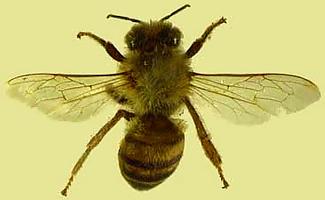
 |


Habitat
Adults: terrestrial
Immatures: terrestrial
Feeding Habits
Adults: nectar and pollen feeding
Immatures: phytophagous
Size: 10 to 25 mm
Flight : strong flier
North American
Species: 47
|
Hymenoptera Apidae
Bumble bees, honey bees, and orchid bees
Front Wings: membranous
Hind Wings: membranous
Mouthparts: chewing
Antenna Length: shorter than body
Antenna Shape: straight
Front Legs: unmodified
Hind Legs: unmodified
Special Characteristics:
These bees are robust and usually hairy. Bumble bees are large bees,usually black and yellow but a few have orange markings. The honey bees are smaller and usually golden brown in colour. Orchid bees are brightly coloured, metallic bees that are more common in tropical regions. These bees have long tongues for feeding on flowers.
|
|
Comments: Many species of bees are social insects. Bumble bees nest in the ground. The fertilized queens which have overwintered choose a nest site in the spring and begins construction. The first brood raised by the queen consists of workers, which will be in charge of enlarging the nest, collecting and storing the food and caring for the larvae. The queen produces eggs. Honey bees nest in manmade hives or in hollow trees. The queen and the workers overwinter in the nest. The queen is unable to start a colony by herself and must use the workers to start a new nest. Bumble bees are important pollinators of various kinds of clover, and honey bees are the most important pollinators for many crops and wild plants.
|
|
Species:
Apis mellifera Linnaeus
Common Name:
Honey bee
Feeding Habits: Adults feed on pollen and nectar, larvae feed on pollen.
Distribution:
Introduced all over Canada.
Comments:
This is an introduced species; most of its colonies are man-made hives. It has been taken to all parts of the world by humans. Colonies normally survive over winter. Honey bees are a very beneficial species, providing pollination of crops, honey and wax.
|

|